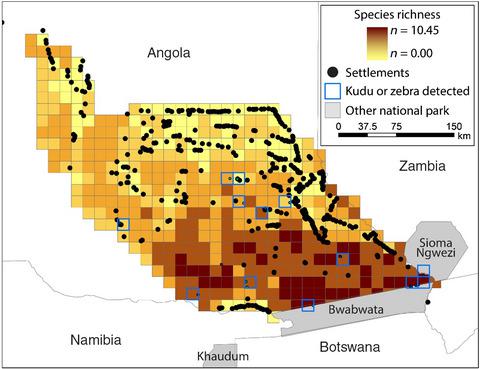当前位置:
X-MOL 学术
›
Anim. Conserv.
›
论文详情
Our official English website, www.x-mol.net, welcomes your feedback! (Note: you will need to create a separate account there.)
Modeling community occupancy from line transect data: a case study with large mammals in post‐war Angola
Animal Conservation ( IF 3.4 ) Pub Date : 2019-12-08 , DOI: 10.1111/acv.12555 L. S. Petracca 1, 2 , P. J. Funston 2 , P. Henschel 2 , J. B. Cohen 1 , S. Maclennan 2 , J. L. Frair 1
Animal Conservation ( IF 3.4 ) Pub Date : 2019-12-08 , DOI: 10.1111/acv.12555 L. S. Petracca 1, 2 , P. J. Funston 2 , P. Henschel 2 , J. B. Cohen 1 , S. Maclennan 2 , J. L. Frair 1
Affiliation

|
Human disturbance can have a profound effect on the occurrence and distribution of wildlife. Such disturbance often extends into protected areas (PAs), particularly in countries that have undergone civil strife and lack the institutional capacity to effectively mitigate anthropogenic threats. We demonstrate the first application of a multi‐species hierarchical occupancy model to spatially correlated detections from vehicle‐based spoor transects, estimating species richness and species‐specific drivers of occurrence of a large mammal community comprising five large carnivores [cheetah (Acinonyx jubatus), leopard (Panthera pardus), lion (Panthera leo), spotted hyena (Crocuta crocuta), and wild dog (Lycaon pictus)] and six large herbivores [buffalo (Syncerus caffer), eland (Taurotragus oryx), elephant (Loxodonta africana), giraffe (Giraffa giraffa), roan (Hippotragus equinus), and sable (Hippotragus niger)] in Luengue‐Luiana and Mavinga National Parks, Angola. This area is the largest contiguous national park complex within a single African country and part of the largest transfrontier conservation area in the world, and is still recovering from the effects of civil war. In this post‐war landscape, the most substantive drivers of community‐level occupancy were anthropogenic, with occupancy associated with lower frequency of human sign, proximity to adjacent national park, and distance away from human settlement. In contrast, ecological variables (precipitation, vegetation cover, seasonal water availability) had less explanatory value. Our results highlight the deleterious effects of human incursion into PAs on the richness and distribution of large mammal species, underscoring the need for intensive mitigation of anthropogenic threats (e.g. poaching, bushmeat hunting) to maintain species of high conservation value in areas impacted by war.
中文翻译:

从线样面数据模拟社区占用:以战后安哥拉大型哺乳动物为例
人为干扰会对野生生物的发生和分布产生深远影响。这种干扰通常会蔓延到保护区,特别是在发生内乱,缺乏有效缓解人为威胁的机构能力的国家。我们演示了多物种分级占用模型在基于车辆的样带空间检测中的首次应用,估算了由五个大型食肉动物[猎豹(Acinonyx jubatus),豹(Panthera pardus),狮子(Panthera leo),斑鬣狗(Crocuta crocuta)和野狗(Lycaon pictus)]和六个大型食草动物[水牛(Syncerus caffer),大羚羊(Taurotragus oryx),大象(Loxodonta africana),长颈鹿(Giraffa giraffa),罗恩(Hippotragus equinus)和黑貂(Hippotragus niger))]在安哥拉的卢恩格·卢安娜(Luengue‐Luiana)和玛文加国家公园(Mavinga National Park)。该地区是单个非洲国家/地区中最大的连续国家公园综合体,并且是世界上最大的跨界保护区的一部分,并且仍在从内战的影响中恢复。在此战后景观中,社区一级占用的最实质性驱动因素是人为因素,其占用与较低的人类标志频率,邻近的国家公园距离以及与人类居住区的距离有关。相反,生态变量(降水,植被覆盖,季节性可用水量)的解释价值较小。我们的研究结果强调了人类入侵PA对大型哺乳动物物种的丰富和分布的有害影响,强调了需要大力缓解人为威胁(例如
更新日期:2019-12-08
中文翻译:

从线样面数据模拟社区占用:以战后安哥拉大型哺乳动物为例
人为干扰会对野生生物的发生和分布产生深远影响。这种干扰通常会蔓延到保护区,特别是在发生内乱,缺乏有效缓解人为威胁的机构能力的国家。我们演示了多物种分级占用模型在基于车辆的样带空间检测中的首次应用,估算了由五个大型食肉动物[猎豹(Acinonyx jubatus),豹(Panthera pardus),狮子(Panthera leo),斑鬣狗(Crocuta crocuta)和野狗(Lycaon pictus)]和六个大型食草动物[水牛(Syncerus caffer),大羚羊(Taurotragus oryx),大象(Loxodonta africana),长颈鹿(Giraffa giraffa),罗恩(Hippotragus equinus)和黑貂(Hippotragus niger))]在安哥拉的卢恩格·卢安娜(Luengue‐Luiana)和玛文加国家公园(Mavinga National Park)。该地区是单个非洲国家/地区中最大的连续国家公园综合体,并且是世界上最大的跨界保护区的一部分,并且仍在从内战的影响中恢复。在此战后景观中,社区一级占用的最实质性驱动因素是人为因素,其占用与较低的人类标志频率,邻近的国家公园距离以及与人类居住区的距离有关。相反,生态变量(降水,植被覆盖,季节性可用水量)的解释价值较小。我们的研究结果强调了人类入侵PA对大型哺乳动物物种的丰富和分布的有害影响,强调了需要大力缓解人为威胁(例如


























 京公网安备 11010802027423号
京公网安备 11010802027423号